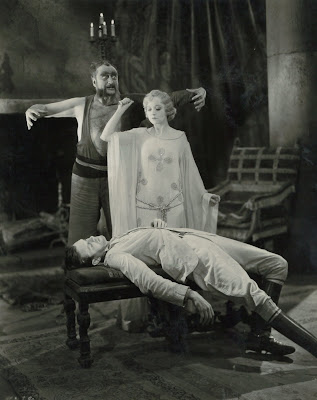

I'm a White Zombie Zombie
At what point do you fall asleep when watching White Zombie? For me, it's about the half point, where Bela Lugosi and assist are removing Madge Bellamy from premature crypt-ternment (that's not a word, is it?). No matter how long I'm out, it always seems they're waiting in that mausoleum for me to rejoin them. All us White Zombies have patience in common. Those 1932 shadows permit me to drift thither/yon and not really miss anything. If White Zombie had a European director, it might enjoy Vampyr's reputation and maybe a Criterion box release. They both work on me like sleeping powders (not to say I don't revere them). So where does Greenbriar come off posting on a film Gary Don Rhodes wrote an entire book about? Well, partly it's fact I've come increasingly round to placing White Zombie among personal Top Five of all 30's horror, a status it could not have achieved in boy days when stations, at least around here, never ran the thing. Again I'm on ground well trodden by others. Has any so cheap a film been covered as extensively? Many cite fairy tales qualities in White Zombie. "Dream-like" has been bandied (having taken me there, I'd concur). Some call it poetic. I'd label White Zombie insistent in its fascination, where all that is good rolls triumphantly over much that isn't. Our generation will have to take White Zombie with us, as I don't look for younger ones to willingly pick up this banner.

Fans of White Zombie are protective of it. They know what they're up against. Late historian George Turner wrote of how he followed WZ from 1932 first-run through multiple screenings at LA's Regina Theatre of reissue legend. Dick Bojarski chased white zombies through Brooklyn flea pits during the late forties, and Arthur Lenig, author of definitive The Count, says he was first to hail it a classic. Bill Everson was a notable champion in his 1974 book Classics Of The Horror Film. They all had to assume a defensive posture in the face of mainstream disdain for White Zombie, exemplified best by a November, 1970 New York Times piece wherein Vincent Canby used terms like immensely absurd, unintentionally funny, and so on to describe a revival booking wherein White Zombie played in support of Freaks (WZ being of a much lesser order than its screen companion, he'd add). I read Canby's smack-down at age sixteen, long before White Zombie came into my life and just assumed he was of a Steven Scheuer persuasion that classed all horror films as junk. Well, hadn't we grown up resigned to such placement by a stuck-up critic's establishment?



Part of White Zombie's appeal comes of its (some say) wretchedly antiquated technique and hard-luck cast. The fact gold was spun of all this is wondrous. Madge Bellamy and John Harron are actors you might imagine plunging into an abyss with zombie unfortunates in the film's final scene, so critcally reviled are their performances. These two did much to foreclose serious recognition for White Zombie, and to some extent, still do. Yet there is minor player Robert Frazer, barely known for much else, giving a good account of what's actually a role of some depth. His foray to Lugosi's sugar mill is perfection itself, a blessed segment for which you'd otherwise forgive White Zombie anything. Sound is put to remarkably creative use throughout. When did filmmakers stop exploring creative possibilities of that new medium? White Zombie does startling things with noise, whether it's cane being ground or a wooden box pushed into a burial vault. Stock music was borrowed from the Lord knows where and works beautifully for not quite fitting situations on screen, while rented sets lend grandeur not expected in a quickie (11 days) with a $62K negative cost.
Bela Lugosi figured they made millions off White Zombie, "they" being the independent producing Halperin brothers. BL managed on short change somewhere north of $750, though likely less than four figures. It galled Lugosi to watch White Zombie on 50's television and know he'd not realize one cent for broadcasts. Many old-timers were of like mind, having performed for flat fees and shut now out of residuals. Lucky teen boys who'd befriended Lugosi would join him tube-side for White Zombie and others of his inventory. Just imagining such makes present day fans swoon. There's really no more a definitive Bela part than this one. Never did he look better or exhibit greater command. White Zombie made some folks rich by 30's standards. Certainly there were profits beyond what even major studio horrors earned. The skinned-to-bone budget was assist toward that. Domestic rentals of $252K and foreign adding another $118K amounted to happy payday for (presumably) the Halperins and distributing United Artists. White Zombie stayed in more or less perpetual release from there on. Houses big and small filled dates with it ... many used WZ as screen lure with on-stage spook acts, some with Lugosi himself in leaner times. Our Liberty Theatre brought it in for a July 1947 date at flat rental of $20 (Charlotte exchange Kay Films being payee). 35mm leasing was handled by Sherman Krellberg, who roamed dealer rooms at collector cons into the seventies (hoping, no doubt, to work one last con of his own). Video peddlers got interested when fans requested White Zombie in something other than muddy prints. A laser disc from the Roan Group finally put things right as possible (considering a long gone camera negative) and their release got mainstream press attention that was a near-first for humble White Zombie. The Roan disc remains best of the many WZ's in circulation (their DVD an improvement even on a mid-nineties restoration the Roans oversaw).



